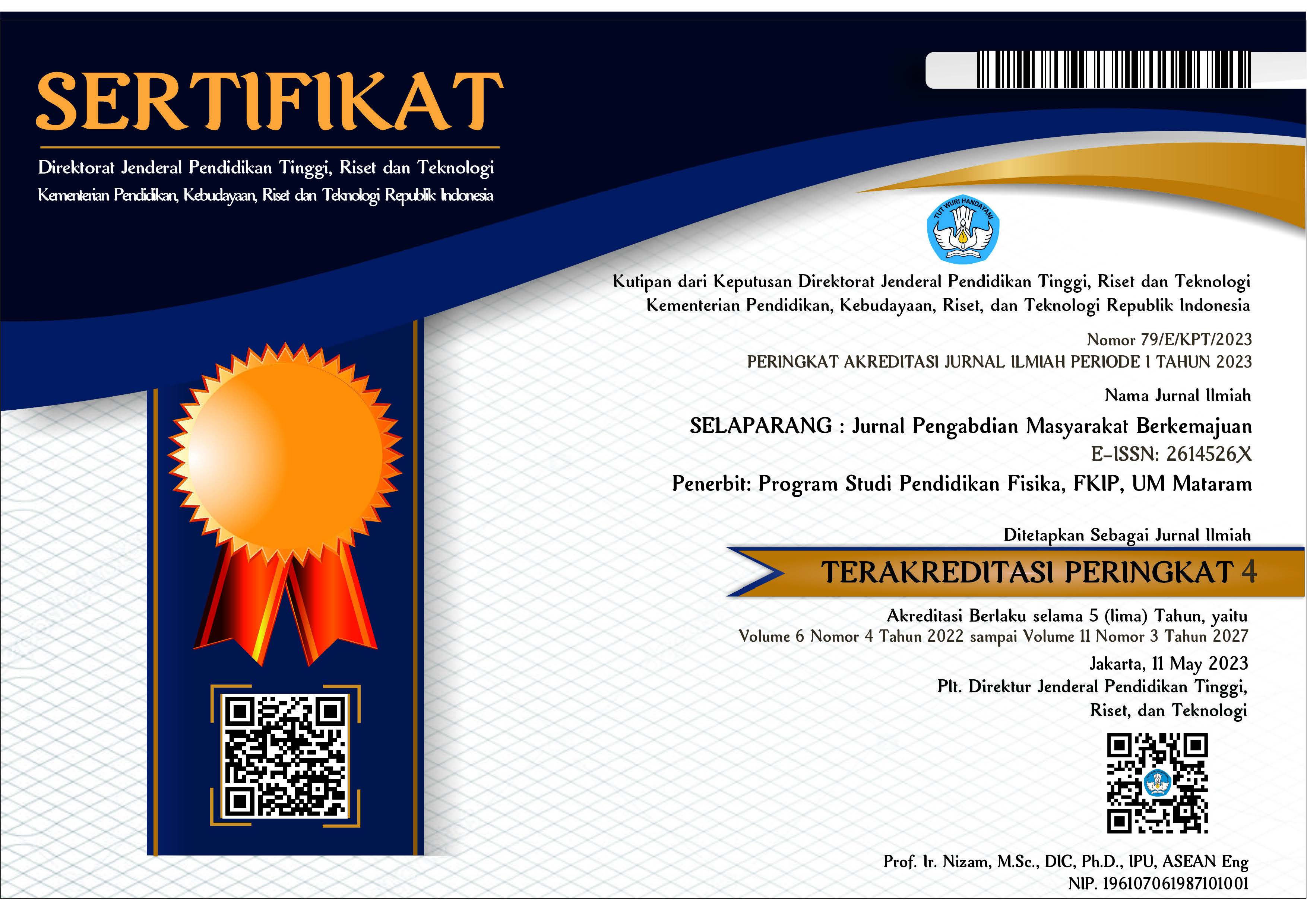PENGUATAN KAPASITAS PEREMPUAN MELALUI KEWIRAUSAAN ECOPRINT
Abstract
ABSTRAK
Adanya kewajiban dosen (Perguruan Tinggi) untuk pengabdian kepada masyarakat, KKN mahasiswa , serta Program pemerintah kota Surabaya untuk pengentasan Masyarakat Berpenghasilan Rendah (MBR), merupakan tantangan bagi Perguruan Tinggi untuk berpartisiasi. Di sisi lain, salah satu kerajinan yang sedang booming adalah ecoprint. Beberapa alasannya adalah : (i) proses produksi tidak terlalu sulit, tidak sesulit membatik, serta (ii) di wilayah Kelurahan Keputih kaya akan tanaman yang daunnya dapat digunakan untuk produksi ecoprint. Tim Pengabdian Masyarakat ITS menggandeng UMKM Sinawa Ecoprint dan Any’s Art & Craft untuk memberdayakan ibu-ibu rumah tangga (pemberdayaan Wanita) warga Kelurahan Keputih, khususnya Masyarakat Berpenghasilan Rendah. Kegiatan ini meliputi pelatihan produksi ecoprint, dilanjutkan dengan mengadopsi konsep sistem intiplasma, UMKM Sinawa Ecoprint dan Any’s Art & Craft sebagai inti yang akan menyediakan sarana produksi, menampung dan memasarkan hasil kerajinan ecoprint ibu-ibu rumah tangga warga Keputih, secara berkelanjutan. Setelah ibu-ibu rumah tangga terampil menghasilkan ecoprint, mereka dapat mejual hasil ecoprint, sehingga mendapatkan tambahan penghasilan bagi keluarga. Selain itu, dampak kegiatan ini diharapkan turut serta berperan dalam upaya PEMKOT Surabaya untuk pengentasan kemiskinan melalui pemberdayaan wanita.
Kata Kunci : pemberdayaan wanita; ecoprint; inti-plasma; berkelanjutan; MBR
ABSTRACT
The existence of the obligation of lecturers (Universities) for community service, student community service activities (KKN), and the Surabaya city government program for alleviating Low-Income Communities (MBR), is a challenge for universities to participate. On the other hand, one of the booming crafts is ecoprint. Some of the reasons are: (i) the production process is not too difficult, not as difficult as batik, and (ii) the Keputih Village area is rich in plants whose leaves can be used for ecoprint production. The ITS Community Service Team collaborates with the Sinawa Ecoprint and Any's Art & Craft SMEs to empower housewives (Women Empowerment) residents of Keputih Village, especially Low-Income Community. This activity includes training on ecoprint production, followed by adopting the concept of the nucleus plasma system, the MSME Sinawa Ecoprint and Any's Art & Craft as the core which will provide production facilities, accommodate and market the ecoprint handicrafts of Keputih housewives, in a sustainable manner. After skilled housewives produce ecoprints, they can sell the ecoprints, thereby earning additional income for the family. In addition, the impact of this activity is expected to play a role in the Surabaya City Government's efforts to alleviate poverty through empowering women.
Keywords: women empowerment; ecoprints; nucleus-plasma system; sustainable; low-income community
Keywords
Full Text:
PDFReferences
Ahmad, A. F., & Hidayati, N. (2018). Pengaruh Jenis Mordan Dan Proses Mordanting Daun Jambu Biji Australia. Indonesian Journal of Halal, 1(2), 1–5.
Aryani, I. K., Wijarnako, B., & Purwandari, R. D. (2022). Tekhnik Eco Print Ramah Lingkungan Berbasis Ekonomis Kreatif Dalam Upaya Menciptakan SDM Masyarakat Mandiri Pasca Pandemi/COVID 19 Untuk Anggota Pimpinan Ranting Aisyiyah (PRA) Desa Karang Cegak Kecamatan Sumbang Kabupaten Banyumas. Jurnal Pengabdian Masyarakat, 3(1), 1–16. https://doi.org/10.32815/jpm.v3i1.461
Asmara, A. D., & Meilani, S. (2020). Penerapan Teknik Ecoprint pada Dedaunan Menjadi Produk Bernilai Jual. Jurnal Pengabdian Seni, 1(2), 16–26. https://journal.isi.ac.id/index.php/JPS/article/view/4706/1957
Bauer, A., & Weber, E. (2021). COVID-19: how much unemployment was caused by the shutdown in Germany? Applied Economics Letters, 28(12), 1053–1058. https://doi.org/10.1080/13504851.2020.1789544
Hikmah, A. R., & Retnasari, D. (2021). Ecoprint Sebagai Alternatif Peluang Usaha Fashion Yang Ramah Lingkungan. Prosiding Pendidikan Teknik Boga Busana FT UNY, 16(1), 1–5.
Kant, R. (2012). Textile dyeing industry an environmental hazard. Natural Science, 04(01), 22–26. https://doi.org/10.4236/ns.2012.41004
Kurniati, A., Mahardika, R., Ikhtiarawati, I. F., Darma, A. S., Rizqi, S. A., & Nuraini, V. (2021). Ecoprint Wujud Ekonomi Kreatif Berbasis Wirausaha dan Kearifan Lokal Dusun Kekep, Parakan, Temanggung. Jurnal Pengabdian Masyarakat Berkemajuan, 4(2), 220–223.
Marianto, M. D. (2020). EcoArt Through Various Approaches. Journal of Urban Society’s Arts, 7(1), 21–29. https://doi.org/10.24821/jousa.v7i1.4084
Naini, U., & Hasmah. (2021). Penciptaan Tekstil Teknik Ecoprint Dengan Memanfaatkan Tumbuhan Lokal Gorontalo. Jurnal Ekspresi Seni, 23(1), 266–276.
Saptutyningsih, E., & Wardani, D. T. K. (2019). Pemanfaatan Bahan Alami Untuk Pengembangan Produk Ecoprint Di Dukuh IV Cerme, Panjatan, Kabupaten Kulonprogo. Warta LPM, 22(1), 18–26. https://doi.org/10.23917/warta.v21i2.6761
Saraswati, R., Susilowati, M. H. D., Restuti, R. C., & Pamungkas, F. D. (2019). Buku Pemanfaatan Daun untuk Ecoprint dalam Menunjang Pariwisata. In Universitas Indonesia (Issue October).
Sedjati, D. P., & Sari, V. T. (2019). Mix Teknik Ecoprint Dan Teknik Batik Berbahan Warna Tumbuhan Dalam Penciptaan Karya Seni Tekstil. Corak Jurnal Seni Kriya, 8(1), 1–11. https://doi.org/10.24821/corak.v8i1.2686
Subiyati, Rosida, A., & Wartiono, T. (2021). COTTON FABRIC ECO-PRINT TRAINING FOR PEDAN TEXTILE VOCATIONAL SCHOOLS. Jurnal Abdi Masya, 1(2), 41–46.
Sunarya, I. K. (2012). Zat Warna Alam Alternatif warna Batik Yang Menarik. Inotek, 16(2), 103–121.
Yaseen, D. A., & Scholz, M. (2019). Textile dye wastewater characteristics and constituents of synthetic effluents: a critical review. International Journal of Environmental Science and Technology, 16(2), 1193–1226. https://doi.org/10.1007/s13762-018-2130-z
DOI: https://doi.org/10.31764/jpmb.v6i4.11871
Refbacks
- There are currently no refbacks.

This work is licensed under a Creative Commons Attribution-ShareAlike 4.0 International License.
______________________________________________________
Jurnal Selaparang
p-ISSN 2614-5251 || e-ISSN 2614-526X
EDITORIAL OFFICE:



















